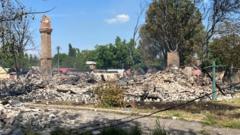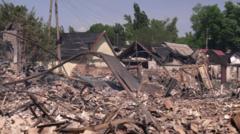In the wake of President Trump's announcement regarding the purported success of U.S. operations in Yemen, military assessments reveal a different story, highlighting the formidable resilience of Houthi forces.
U.S. Military's Yemen Operations Face Challenges Despite Heavy Bombing

U.S. Military's Yemen Operations Face Challenges Despite Heavy Bombing
Pentagon's three-week Operation Rough Rider proves costly with limited impact on Houthi militia.
In just three weeks of intensive air strikes against Houthi militants in Yemen, the U.S. military has expended a staggering $200 million in munitions. This operation, referred to as "Operation Rough Rider," commenced on March 15, following President Trump's assertion that Houthi forces have been “decimated by the relentless strikes.” However, private intelligence from the Pentagon tells a more nuanced tale, suggesting limited success in dismantling the Houthis' extensive underground arsenal of missiles, drones, and launcher systems, as reported in recent closed briefings to Congress and allied nations.
According to military officials familiar with damage assessments, the intensity of current bombing missions exceeds those conducted during the previous Biden administration, but they have not achieved the desired effect on Houthi capabilities. The resilient Houthi forces have reportedly reinforced many of their bunkers and installation sites, complicating U.S. efforts to disrupt their missile attacks targeting commercial vessels in the strategically crucial Red Sea.
The recent military campaign has not only drained substantial financial resources but has also involved significant operational costs, including the deployment of two aircraft carriers, multiple B-2 bombers, fighter jets, and air defense systems such as Patriot and THAAD to the region. These actions highlight the escalating stakes in the American military presence in the Middle East, as the situation in Yemen continues to challenge U.S. objectives against Houthi provocations.
As Washington weighs future strategy amid these revelations, the dynamic nature of the conflict in Yemen raises important questions about efficacy, expenditure, and the broader implications for regional stability.
According to military officials familiar with damage assessments, the intensity of current bombing missions exceeds those conducted during the previous Biden administration, but they have not achieved the desired effect on Houthi capabilities. The resilient Houthi forces have reportedly reinforced many of their bunkers and installation sites, complicating U.S. efforts to disrupt their missile attacks targeting commercial vessels in the strategically crucial Red Sea.
The recent military campaign has not only drained substantial financial resources but has also involved significant operational costs, including the deployment of two aircraft carriers, multiple B-2 bombers, fighter jets, and air defense systems such as Patriot and THAAD to the region. These actions highlight the escalating stakes in the American military presence in the Middle East, as the situation in Yemen continues to challenge U.S. objectives against Houthi provocations.
As Washington weighs future strategy amid these revelations, the dynamic nature of the conflict in Yemen raises important questions about efficacy, expenditure, and the broader implications for regional stability.






















